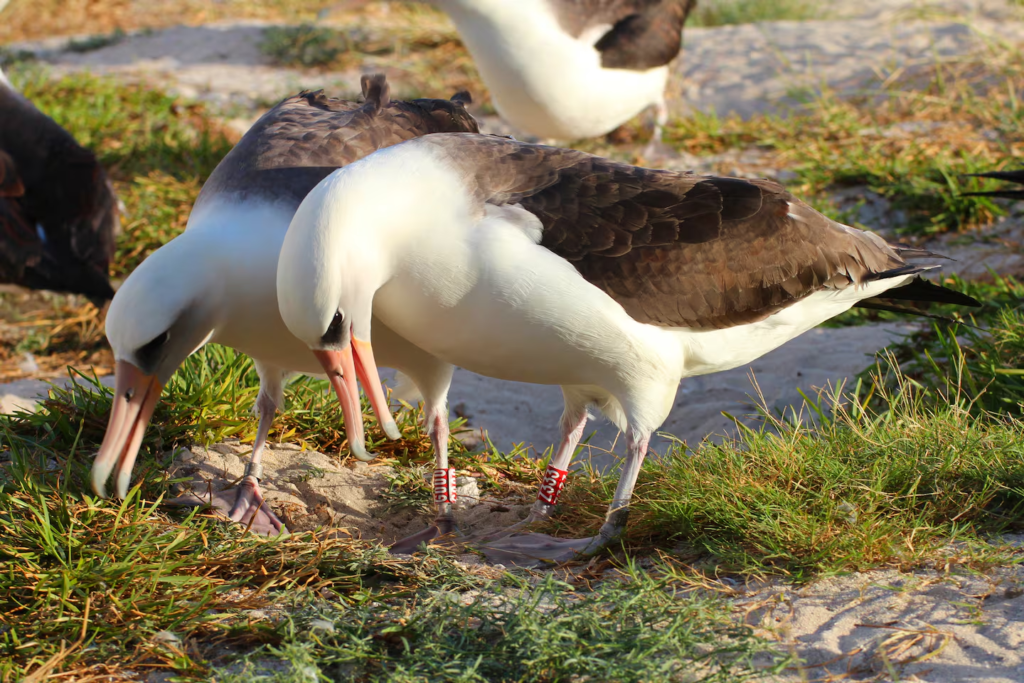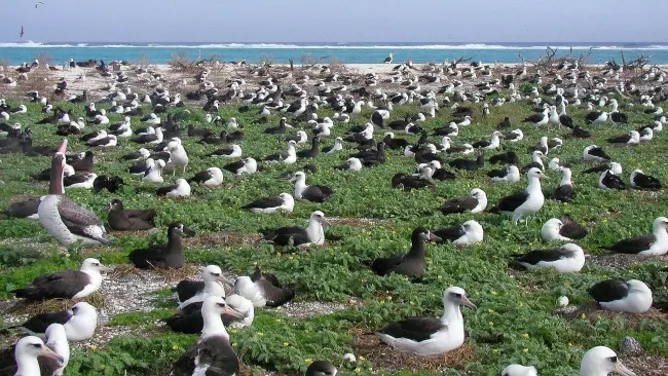At 74 years old, Wisdom, the World’s Oldest Known Wild Bird, has once again defied the odds by laying another egg. This remarkable feat, accomplished at Midway Atoll in the Pacific Ocean, not only challenges our understanding of bird biology but also serves as an inspiring story of resilience, adaptation, and longevity.
Wisdom, a Laysan albatross, has become a global symbol of endurance, captivating the hearts of wildlife enthusiasts and scientists alike.
Wisdom’s Incredible Journey: From Tagging to Record-Breaking
Wisdom’s story began in 1956 when she was first tagged by biologists at the Midway Atoll National Wildlife Refuge. At the time, she was estimated to be about five years old.
Over the decades, this remarkable bird has continued to return to Midway to breed, outliving not only her peers but also several of her mates. In a species where the average lifespan ranges from 12 to 40 years, her’s longevity is nothing short of extraordinary.
The Midway Atoll, part of the Hawaiian archipelago, serves as the largest albatross colony in the world. Each year, millions of Laysan albatrosses return to this remote refuge to breed, but none have captured the public’s imagination quite like Wisdom. Her story is a testament to the success of conservation efforts and the importance of preserving natural habitats for wildlife.
Read : Bird Flu Killed 47 Tigers in Vietnam Zoos
What makes Wisdom’s journey even more astonishing is her reproductive success. She has raised more than 30 chicks over her lifetime, with her last known offspring hatching in 2021.
SHE DID IT AGAIN!
— USFWS Pacific (@USFWSPacific) December 3, 2024
Wisdom, the world’s oldest known wild bird, is back with a new partner and just laid yet another egg.
At an approximate age of 74, the queen of seabirds returned to Midway Atoll National Wildlife Refuge last week and began interacting with a male. pic.twitter.com/6qomvs0rKL
This year, she returned with a new partner, as her previous mate, Akeakamai, has not been seen for several years. While Laysan albatrosses typically mate for life, Wisdom has outlived at least three partners, adapting to new relationships to continue the cycle of life.
The Science Behind Wisdom’s Longevity
Wisdom’s extraordinary lifespan raises important questions about avian biology and the factors contributing to her longevity. Typically, Laysan albatrosses reach sexual maturity around five years of age and can live up to 40 years under ideal conditions. She has more than doubled this expected lifespan, defying the natural limits of her species.
One factor contributing to her longevity may be her migratory and breeding habits. Laysan albatrosses are pelagic birds, spending most of their lives soaring over the open ocean and feeding on squid and fish.
This lifestyle, though challenging, may reduce exposure to some of the predators and diseases that land-based birds face. Additionally, the Midway Atoll National Wildlife Refuge provides a relatively protected environment, free from many of the human-made threats that endanger other seabird populations.

Genetics likely play a role as well. Wisdom’s robust health and reproductive success suggest that she may possess genetic traits that confer increased resistance to disease and stress. Understanding these traits could offer valuable insights into the aging process, not just for birds but potentially for other species as well.
Biologists like Jon Plissner, who oversees wildlife at the Midway Atoll, have expressed their amazement at Wisdom’s continued vitality.
Plissner noted that there are no known wild birds even close to her age, with the second-oldest Laysan albatross being around 45. This makes Wisdom a unique case study, offering a rare opportunity to study the factors that contribute to extreme longevity in the wild.
The Importance of Conservation and Global Impact
Wisdom’s story is not just about one bird; it is a powerful reminder of the importance of conservation efforts. The Midway Atoll National Wildlife Refuge, where Wisdom has nested for decades, plays a crucial role in protecting seabird populations. This remote island is home to over two million albatrosses, making it the largest albatross colony in the world.
The success of the refuge is a testament to the impact of long-term conservation initiatives. In the mid-20th century, albatross populations faced significant threats from human activities, including hunting, habitat destruction, and pollution.
Thanks to concerted efforts by organizations like the US Fish and Wildlife Service, populations have stabilized, and stories like Wisdom’s have become possible.

However, challenges remain. Albatrosses are still vulnerable to threats such as plastic pollution, climate change, and longline fishing. Plastic debris, in particular, poses a significant danger, as birds often mistake it for food, leading to ingestion and injury. Climate change also impacts their food supply and breeding habitats, making the work of wildlife refuges more critical than ever.
Wisdom’s continued survival and reproductive success underscore the importance of protecting these fragile ecosystems. Her story has captured global attention, inspiring renewed interest in seabird conservation. Each year, scientists and nature lovers wait anxiously for her return, viewing her as a symbol of hope and resilience in an increasingly uncertain world.
As She prepares to nurture yet another chick, her legacy extends beyond her own remarkable journey. She represents the resilience of nature and the impact of human intervention—both positive and negative. Her story highlights the delicate balance that exists in our ecosystems and the role we play in preserving it.

For scientists, Wisdom offers a living laboratory for studying aging, reproduction, and survival strategies in the wild. Each year she returns provides new data that can help us understand the broader challenges faced by seabirds and other wildlife.
Her ability to adapt to new partners and continue reproducing well into her 70s challenges our assumptions about the limits of avian biology.
For the broader public, Wisdom’s story is a reminder of the interconnectedness of all life. Her journey, from a young bird tagged in 1956 to a global icon of resilience, illustrates the power of perseverance and the importance of protecting our natural world. As we face environmental challenges, her story serves as a beacon of hope and a call to action.
Wisdom’s remarkable journey is more than just a story about a bird. It is a testament to the enduring power of life, the importance of conservation, and the incredible resilience of nature. As she continues to defy the odds, she reminds us all of what is possible when we protect and preserve the world around us.
let’s enjoy few years on earth with peace and happiness….✍🏼🙏

